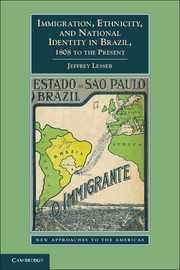Book contents
- Frontmatter
- Contents
- List of Figures, Tables, and Documents
- Acknowledgments
- Chapter 1 Creating Brazilians
- Chapter 2 From Central Europe and Asia
- Chapter 3 Mass Migrations, 1880–1920
- Chapter 4 The Creation of Euro-Brazilian Identities
- Chapter 5 How Arabs Became Jews, 1880–1940
- Chapter 6 Asianizing Brazil
- Epilogue
- Historiographical Essay
- Index
- References
Epilogue
The Song Remains the Same
Published online by Cambridge University Press: 05 February 2013
- Frontmatter
- Contents
- List of Figures, Tables, and Documents
- Acknowledgments
- Chapter 1 Creating Brazilians
- Chapter 2 From Central Europe and Asia
- Chapter 3 Mass Migrations, 1880–1920
- Chapter 4 The Creation of Euro-Brazilian Identities
- Chapter 5 How Arabs Became Jews, 1880–1940
- Chapter 6 Asianizing Brazil
- Epilogue
- Historiographical Essay
- Index
- References
Summary
New Policies for a New Era
Brazil changed markedly between the Great Depression and the end of World War II. Coffee, the driver of the economy since the late nineteenth century, declined as prices and market percentage dropped. Coffee plantations in São Paulo and Rio de Janeiro were abandoned, divided, or sold. Brazil’s fazendas, run for centuries as family fiefdoms, often became the property of large corporations that began to harvest products like soybeans and sugarcane for local and international markets.
The changes in agricultural production, new infusions of international capital, and increasing orientation to export led to industrial growth. Some plantation owners had begun investing in factories in the nineteenth century and that trend continued. Numerous immigrants and their descendants did the same. By end of the twentieth century, industrial Brazil was producing everything from automobiles to airplanes.
Immigration patterns also changed in the years surrounding World War II. From 1942 to 1945, most ports were closed to passenger traffic and transoceanic travel became increasingly dangerous. In the United States, new permanent resident permits dropped below thirty thousand per year (during the previous forty years the average had been almost half a million per year, with many single years reaching over a million). Argentina’s numbers also dropped substantially. The decline was most dramatic in Brazil. Immigrant entries virtually stopped, falling below two thousand per year.
- Type
- Chapter
- Information
- Publisher: Cambridge University PressPrint publication year: 2013

